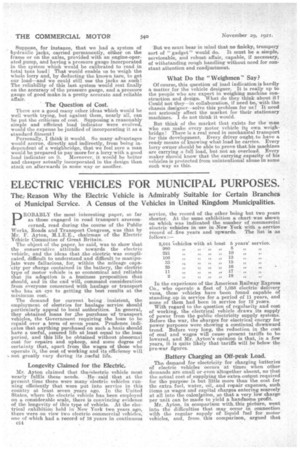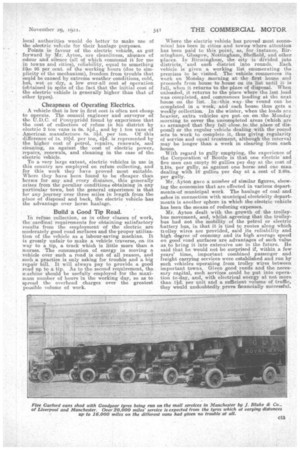ELECTRIC VEHICLES FOR MUNICIPAL PURPOSES.
Page 12

Page 13

If you've noticed an error in this article please click here to report it so we can fix it.
The,, Reason Why the Electric Vehicle is Admirably Suitable for Certain Branches of Municipal Service. A Census of the Vehicles in United Kingdom Municipalities.
pROBABLY the most interesting paper, so far as those engaged in road transport aretconcerned, read during the course of the Public Works, Roads and Transport Congress was that by Mr. F. Ayton, M.I.E.E., chairman of the Electric Vehicle Committee of Great Britain.
The object of the paper, he said, was to show that the conservative attitude towards the electric vehicle, and the ideas that the electric was complicated, difficult to understand and difficult to manipulate were fallacious, for within the mileage capacity per charge contained in the battery, the electric type of motor vehicle is so economical and reliable that its adoption is a business proposition that should, and in the end will, command consideration from everyone concerned with haulage or transport who has an eye to getting the best results at the minimum cost.
The demand for current being insistent, the employment of electrice for haulage service should particularly appeal to local authorities. In general, they obtained loans for the purchase of transport vehicles, the Government requiring the loan to be repaid over a term of seven years_ Prudence indicates that anything purehased on such a basis should have a useful, assured life at least equal to the loan period, and this life be obtained without abnormal cost for repairs and upkeep, and some degree of certainty that, apart from the wages of those who operate it the cost of working and its efficiency will s not greatly vary during its useful life.
Longevity Claimed for the Electric.
Mr. Ayton claimed that theeelectric vehicle most nearly fulfils these needs. lie -said that at the present time there were many electric vehicles running efficiently that were put into service in this country at least seven years ago. In the United States, where the electric vehicle has been employed on a considerable sealer there is convincing evidence of the longevity of this type of vehicle. At the electrical exhibition held in New York two years ago, there were on view two electric commercial vehicles, one of which had a record of 16 years in continuous c14 service, the record of the other being but two years shorter. At the same exhibition a chart was shown on which was indicated the number of commercial electric vehicles in use in New York with a service record of five years and upwards. The list is as follows
2,044 -vehicles with at least 5 years' service.
980 11 1/ 71. 8 11 221 1.1 11 )/ /1 10 >1 /• 106 11 11 /1 13 33 SS. /1 /3 15 11 31 25 J./ I/ 1/ 16 // ii 1, 11 /1 17 /1 2 I) .1, 18 S/
In the experience of the American Railway Express Co., who operate a fleet of 1,058 electric delivery vans, these vehicles have been found capable of standing .up in service for a period of 11 years, and some of them had been in service for /2 years.
With regard to the question of regularity and cost of working, the electrical vehicle draws its supply of power from the public electricity supply systems. Before the, war, the charges for electrical energy for power purposes were showing a continual downward trend. Before very long, the reduction in the cost of coal and wages will cause present tariffs to be lowered, and Mr. Ayton's opinion is that, in a few years, it is quite likely that tariffs will be below the pre-war figures.
Battery Charging an Off-peak Load.
The. demand for electricity for charging batteries of electric vehicles occurs at times when other demands are small or even altogether absent, so that the actual cost of supplying the extra, output required for the, purpose is but little more than the cost for the extra fuel, water, oil, and repair expenses, such items as wages and capital charges entering scarcely at all into the caleulatren, so that a very low charge per unit can be made to yield a handsome profit. Mr. Ayton, in comparison with .this picture, went into the difficulties that may occur in connection with the regular supply of liquid fuel for motor vehicles, and. from this comparison, argued that local authorities would do better to make use of the electric vehicle for their haulage purposes. Points in favour of the electric vehicle, as put forward by Mr. AyLon, are cleanliness, absence of odour and silence (all of which commend it for use in towns and cities), reliability, equal to something like 95 per cent. of the working hours (due to simplicity of the mechanism), freedom from trouble that could be caused by extreme weather conditions, cold, hot, wet or dry, a low over-all cost of operation (obtained in spite of the fact that the initial coat of the electric vehicle is generally higher than that of other types).
Cheapness of Operating Electrics.
• A vehicle that is low in first cost is often not cheap to operate. The council engineer and surveyor of the U.D.C. of Pontypridd found by experience that the cost of collection of refuse in his district by electric 2 ton vans is 6s. 51-d_, and by 1 ton vans of American manufacture 8s. 31d. per ton. Of this difference of Is. 101-d. per ton, 4.1.d. is represented by the higher cost of petrol, repairs, renewals, and cleaning, as against the cost of electric power,, repairs, renewals, and cleaning in the ease of the electric vehicle.
To a very large extent, electric vehicles in use in, this country are employed on refuse collecting, and for this work they have proved most suitable. Where they have been found to be cheaper. than horses for any and every distance, this generally arises from the peculiar conditions obtaining in any particular town, but the general experience is that for any journey over three miles in length from the place of disposal and back, the electric vehicle •has the advantage over horse haulage.
Build a Good Tip Road.
In refuse collection, as in other classes of work, the cardinal requirements for obtaining satisfactory results from the employment of the electric are moderately good road surfaces and the-proper utilization of the vehicle as a labour-saving machine. It is grossly unfair to make a vehicle traverse, on its way to a tip, a track which is little more than a morass. The consumption of energy in moving a vehicle over such a road is out of all reason, and such a practice is only asking for trouble and a big renair bill. It will always pay to provide a good road up to a tip. As to the second requirement, tho machine should be usefully employed for the maximum number of hours in the working day, so as to spread the overhead charges over the greatest possible volume of work. Where the electric vehicle has proved most economical has been in cities and towns where attention has been paid to this point, as, for instance, Birmingham, Glasgow, Nottingham, Sheffield, and other places. In Birmingham, the city is divided into districts-, 'and each district" into rounds. Each vehicle is given a. working list enumerating the premises to be visited. The vehicle commences its work on Monday morning at the first house and proceeds from house to house on its list until it is full, when it returns to the place of disposal. When unloaded, it returns to the place where the last load was completed, and commences loading at the next house on the list. •.Insthis way the round can be completed in a week, and each house thus gets a weekly collection. In the winter, when the loads are heavier, extra vehicles are put on on the Monday morning to cover the nu-completed areas (which are S3 arranged that they fall closest, the place of disposal) or the regular vehicle dealing with the round sets to work to complete it, thus giving regularity of service and equal treatment, although the interval may be longer than. a week in clearing from each house.
With regard to gully emptying, the experience of the Corporation of Bootle is that one electric and five men can empty 80 gullies per day at the cost of 2.18s, per gully, as against one horse and one man dealing with 16 gullies per day at a cost of 2.68s. per gully.
Mr. Ay-ton gave a number of similar figures, show-. ing the economies that are effected in various departnients..of municipal work. The haulage of coal and ashes in connection with municipal electricity departanents is another sphere in which the electric vehicle has been the means of reducing expenses.
Mr. Ayton dealt with the growth of the trolleybus movement, and, whilst agreeing that the trolleybus had not the mobility of the petrol or electric battery bus, in that it is tied to routes along which olley wires are provided, said its reliability and high degree of economy and its high average speed on good road surfaces are advantages of such value as to bring it into extensive use in the future. He said that he would not be surprised if, within a few years' time, important combined passenger and freight carrying services were established and run by such vehicles operating from trolley wires between important towns. Given good roads and the necessary capital, such services could be put into operation to-clay, and, with electrical energy at not morn than lid. per unit and a sufficient volume of traffic, they would undoubtedly, prove financially successful.
































